Inflation Impact on Australian Retail Sector: A Woolworths Case Study
VerifiedAdded on 2023/06/13
|11
|2741
|450
Case Study
AI Summary
This case study investigates the impact of inflation on the performance of the Australian retail sector, using Woolworths as a specific example. It explores the relationship between inflation and key financial metrics such as return on equity, earnings per share, and overall profitability. The study reviews existing literature on the effects of inflation on business performance and economic variables. Employing an ex post facto research design and analyzing secondary data from Woolworths' annual reports (2000-2017) using Ordinary Least Squares (OLS) regression, the research aims to determine the extent to which inflation influences the company's financial health and operational efficiency. The findings are intended to provide insights for retail organizations in navigating inflationary pressures and sustaining performance in a competitive market. Desklib provides a platform for students to access this and many other solved assignments.

Impact of inflation on the performance of the Australian Retail Sector: A case study of
Woolworths
Name of the student
Name of the University
Author Note
Woolworths
Name of the student
Name of the University
Author Note
Paraphrase This Document
Need a fresh take? Get an instant paraphrase of this document with our AI Paraphraser
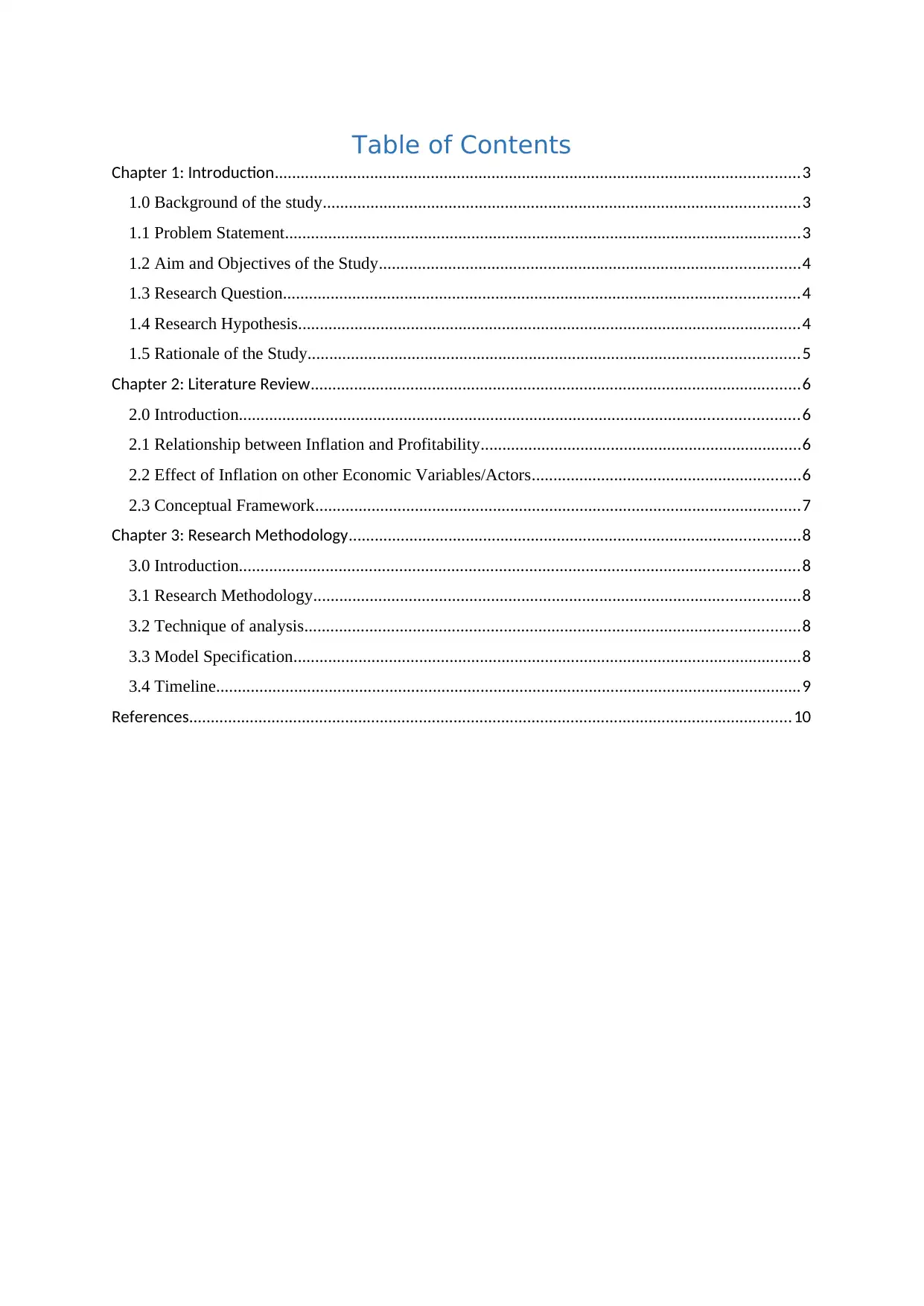
Table of Contents
Chapter 1: Introduction.........................................................................................................................3
1.0 Background of the study..............................................................................................................3
1.1 Problem Statement.......................................................................................................................3
1.2 Aim and Objectives of the Study.................................................................................................4
1.3 Research Question.......................................................................................................................4
1.4 Research Hypothesis....................................................................................................................4
1.5 Rationale of the Study.................................................................................................................5
Chapter 2: Literature Review.................................................................................................................6
2.0 Introduction.................................................................................................................................6
2.1 Relationship between Inflation and Profitability..........................................................................6
2.2 Effect of Inflation on other Economic Variables/Actors..............................................................6
2.3 Conceptual Framework................................................................................................................7
Chapter 3: Research Methodology........................................................................................................8
3.0 Introduction.................................................................................................................................8
3.1 Research Methodology................................................................................................................8
3.2 Technique of analysis..................................................................................................................8
3.3 Model Specification.....................................................................................................................8
3.4 Timeline.......................................................................................................................................9
References...........................................................................................................................................10
Chapter 1: Introduction.........................................................................................................................3
1.0 Background of the study..............................................................................................................3
1.1 Problem Statement.......................................................................................................................3
1.2 Aim and Objectives of the Study.................................................................................................4
1.3 Research Question.......................................................................................................................4
1.4 Research Hypothesis....................................................................................................................4
1.5 Rationale of the Study.................................................................................................................5
Chapter 2: Literature Review.................................................................................................................6
2.0 Introduction.................................................................................................................................6
2.1 Relationship between Inflation and Profitability..........................................................................6
2.2 Effect of Inflation on other Economic Variables/Actors..............................................................6
2.3 Conceptual Framework................................................................................................................7
Chapter 3: Research Methodology........................................................................................................8
3.0 Introduction.................................................................................................................................8
3.1 Research Methodology................................................................................................................8
3.2 Technique of analysis..................................................................................................................8
3.3 Model Specification.....................................................................................................................8
3.4 Timeline.......................................................................................................................................9
References...........................................................................................................................................10
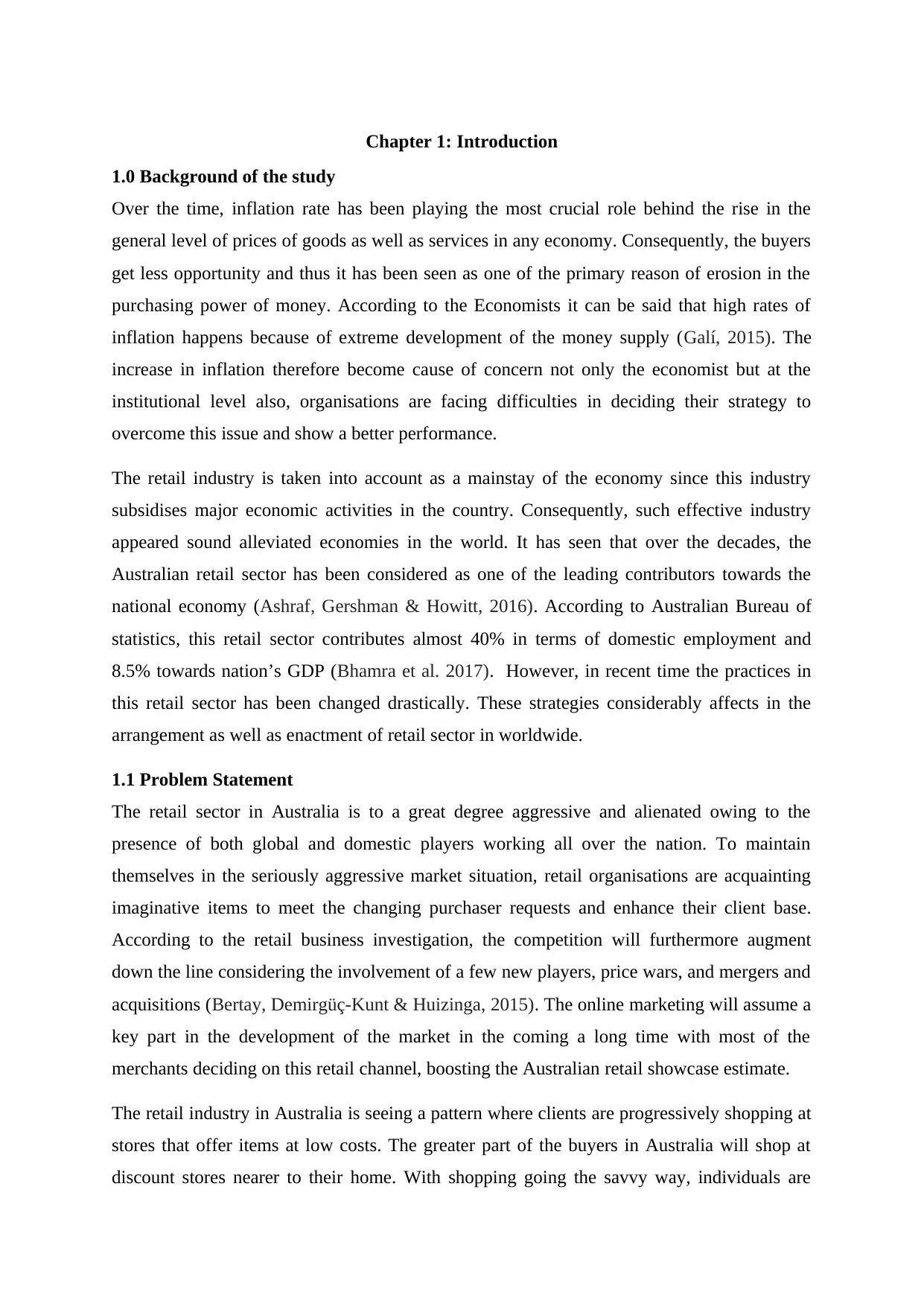
Chapter 1: Introduction
1.0 Background of the study
Over the time, inflation rate has been playing the most crucial role behind the rise in the
general level of prices of goods as well as services in any economy. Consequently, the buyers
get less opportunity and thus it has been seen as one of the primary reason of erosion in the
purchasing power of money. According to the Economists it can be said that high rates of
inflation happens because of extreme development of the money supply (Galí, 2015). The
increase in inflation therefore become cause of concern not only the economist but at the
institutional level also, organisations are facing difficulties in deciding their strategy to
overcome this issue and show a better performance.
The retail industry is taken into account as a mainstay of the economy since this industry
subsidises major economic activities in the country. Consequently, such effective industry
appeared sound alleviated economies in the world. It has seen that over the decades, the
Australian retail sector has been considered as one of the leading contributors towards the
national economy (Ashraf, Gershman & Howitt, 2016). According to Australian Bureau of
statistics, this retail sector contributes almost 40% in terms of domestic employment and
8.5% towards nation’s GDP (Bhamra et al. 2017). However, in recent time the practices in
this retail sector has been changed drastically. These strategies considerably affects in the
arrangement as well as enactment of retail sector in worldwide.
1.1 Problem Statement
The retail sector in Australia is to a great degree aggressive and alienated owing to the
presence of both global and domestic players working all over the nation. To maintain
themselves in the seriously aggressive market situation, retail organisations are acquainting
imaginative items to meet the changing purchaser requests and enhance their client base.
According to the retail business investigation, the competition will furthermore augment
down the line considering the involvement of a few new players, price wars, and mergers and
acquisitions (Bertay, Demirgüç-Kunt & Huizinga, 2015). The online marketing will assume a
key part in the development of the market in the coming a long time with most of the
merchants deciding on this retail channel, boosting the Australian retail showcase estimate.
The retail industry in Australia is seeing a pattern where clients are progressively shopping at
stores that offer items at low costs. The greater part of the buyers in Australia will shop at
discount stores nearer to their home. With shopping going the savvy way, individuals are
1.0 Background of the study
Over the time, inflation rate has been playing the most crucial role behind the rise in the
general level of prices of goods as well as services in any economy. Consequently, the buyers
get less opportunity and thus it has been seen as one of the primary reason of erosion in the
purchasing power of money. According to the Economists it can be said that high rates of
inflation happens because of extreme development of the money supply (Galí, 2015). The
increase in inflation therefore become cause of concern not only the economist but at the
institutional level also, organisations are facing difficulties in deciding their strategy to
overcome this issue and show a better performance.
The retail industry is taken into account as a mainstay of the economy since this industry
subsidises major economic activities in the country. Consequently, such effective industry
appeared sound alleviated economies in the world. It has seen that over the decades, the
Australian retail sector has been considered as one of the leading contributors towards the
national economy (Ashraf, Gershman & Howitt, 2016). According to Australian Bureau of
statistics, this retail sector contributes almost 40% in terms of domestic employment and
8.5% towards nation’s GDP (Bhamra et al. 2017). However, in recent time the practices in
this retail sector has been changed drastically. These strategies considerably affects in the
arrangement as well as enactment of retail sector in worldwide.
1.1 Problem Statement
The retail sector in Australia is to a great degree aggressive and alienated owing to the
presence of both global and domestic players working all over the nation. To maintain
themselves in the seriously aggressive market situation, retail organisations are acquainting
imaginative items to meet the changing purchaser requests and enhance their client base.
According to the retail business investigation, the competition will furthermore augment
down the line considering the involvement of a few new players, price wars, and mergers and
acquisitions (Bertay, Demirgüç-Kunt & Huizinga, 2015). The online marketing will assume a
key part in the development of the market in the coming a long time with most of the
merchants deciding on this retail channel, boosting the Australian retail showcase estimate.
The retail industry in Australia is seeing a pattern where clients are progressively shopping at
stores that offer items at low costs. The greater part of the buyers in Australia will shop at
discount stores nearer to their home. With shopping going the savvy way, individuals are
⊘ This is a preview!⊘
Do you want full access?
Subscribe today to unlock all pages.

Trusted by 1+ million students worldwide
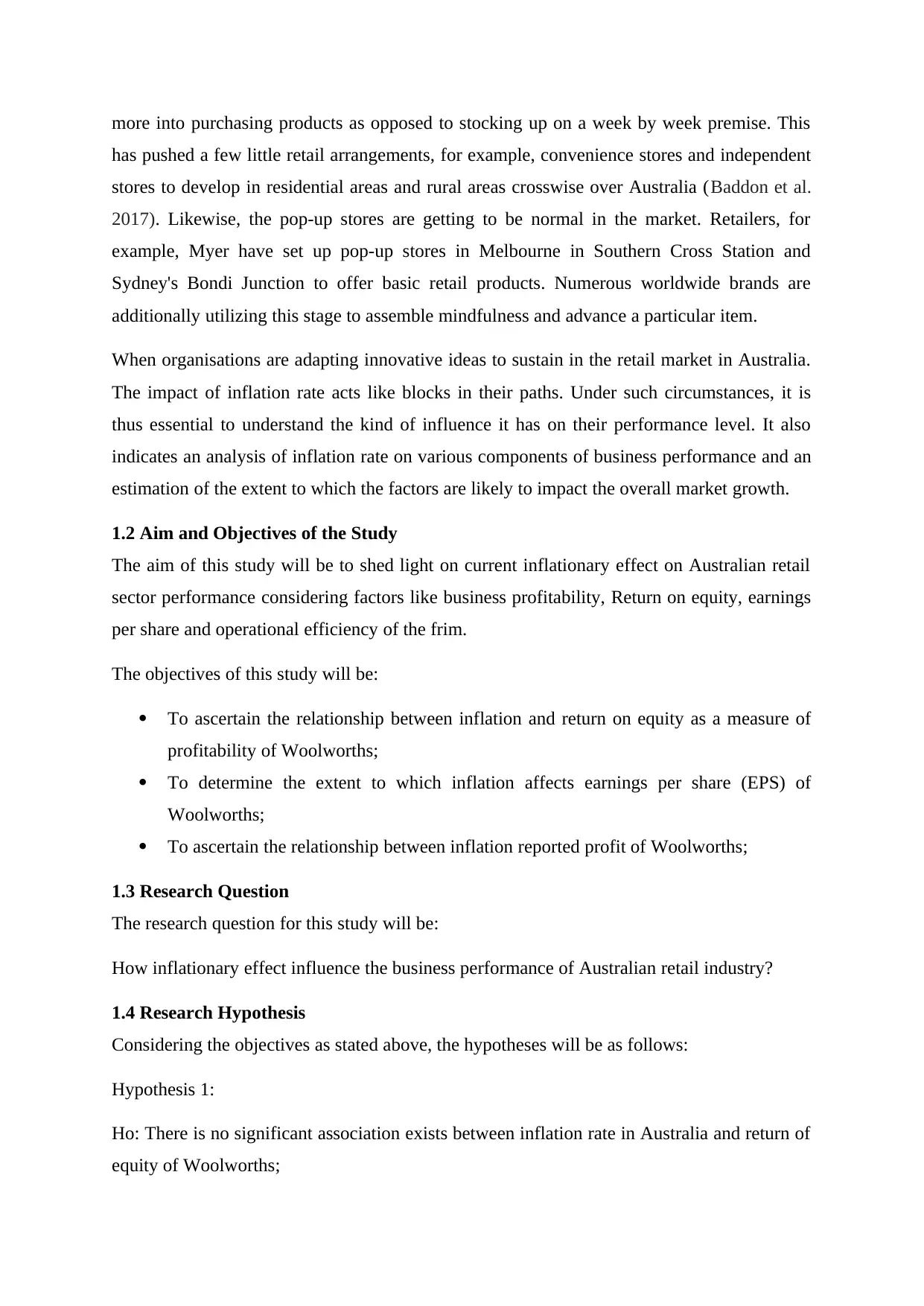
more into purchasing products as opposed to stocking up on a week by week premise. This
has pushed a few little retail arrangements, for example, convenience stores and independent
stores to develop in residential areas and rural areas crosswise over Australia (Baddon et al.
2017). Likewise, the pop-up stores are getting to be normal in the market. Retailers, for
example, Myer have set up pop-up stores in Melbourne in Southern Cross Station and
Sydney's Bondi Junction to offer basic retail products. Numerous worldwide brands are
additionally utilizing this stage to assemble mindfulness and advance a particular item.
When organisations are adapting innovative ideas to sustain in the retail market in Australia.
The impact of inflation rate acts like blocks in their paths. Under such circumstances, it is
thus essential to understand the kind of influence it has on their performance level. It also
indicates an analysis of inflation rate on various components of business performance and an
estimation of the extent to which the factors are likely to impact the overall market growth.
1.2 Aim and Objectives of the Study
The aim of this study will be to shed light on current inflationary effect on Australian retail
sector performance considering factors like business profitability, Return on equity, earnings
per share and operational efficiency of the frim.
The objectives of this study will be:
To ascertain the relationship between inflation and return on equity as a measure of
profitability of Woolworths;
To determine the extent to which inflation affects earnings per share (EPS) of
Woolworths;
To ascertain the relationship between inflation reported profit of Woolworths;
1.3 Research Question
The research question for this study will be:
How inflationary effect influence the business performance of Australian retail industry?
1.4 Research Hypothesis
Considering the objectives as stated above, the hypotheses will be as follows:
Hypothesis 1:
Ho: There is no significant association exists between inflation rate in Australia and return of
equity of Woolworths;
has pushed a few little retail arrangements, for example, convenience stores and independent
stores to develop in residential areas and rural areas crosswise over Australia (Baddon et al.
2017). Likewise, the pop-up stores are getting to be normal in the market. Retailers, for
example, Myer have set up pop-up stores in Melbourne in Southern Cross Station and
Sydney's Bondi Junction to offer basic retail products. Numerous worldwide brands are
additionally utilizing this stage to assemble mindfulness and advance a particular item.
When organisations are adapting innovative ideas to sustain in the retail market in Australia.
The impact of inflation rate acts like blocks in their paths. Under such circumstances, it is
thus essential to understand the kind of influence it has on their performance level. It also
indicates an analysis of inflation rate on various components of business performance and an
estimation of the extent to which the factors are likely to impact the overall market growth.
1.2 Aim and Objectives of the Study
The aim of this study will be to shed light on current inflationary effect on Australian retail
sector performance considering factors like business profitability, Return on equity, earnings
per share and operational efficiency of the frim.
The objectives of this study will be:
To ascertain the relationship between inflation and return on equity as a measure of
profitability of Woolworths;
To determine the extent to which inflation affects earnings per share (EPS) of
Woolworths;
To ascertain the relationship between inflation reported profit of Woolworths;
1.3 Research Question
The research question for this study will be:
How inflationary effect influence the business performance of Australian retail industry?
1.4 Research Hypothesis
Considering the objectives as stated above, the hypotheses will be as follows:
Hypothesis 1:
Ho: There is no significant association exists between inflation rate in Australia and return of
equity of Woolworths;
Paraphrase This Document
Need a fresh take? Get an instant paraphrase of this document with our AI Paraphraser
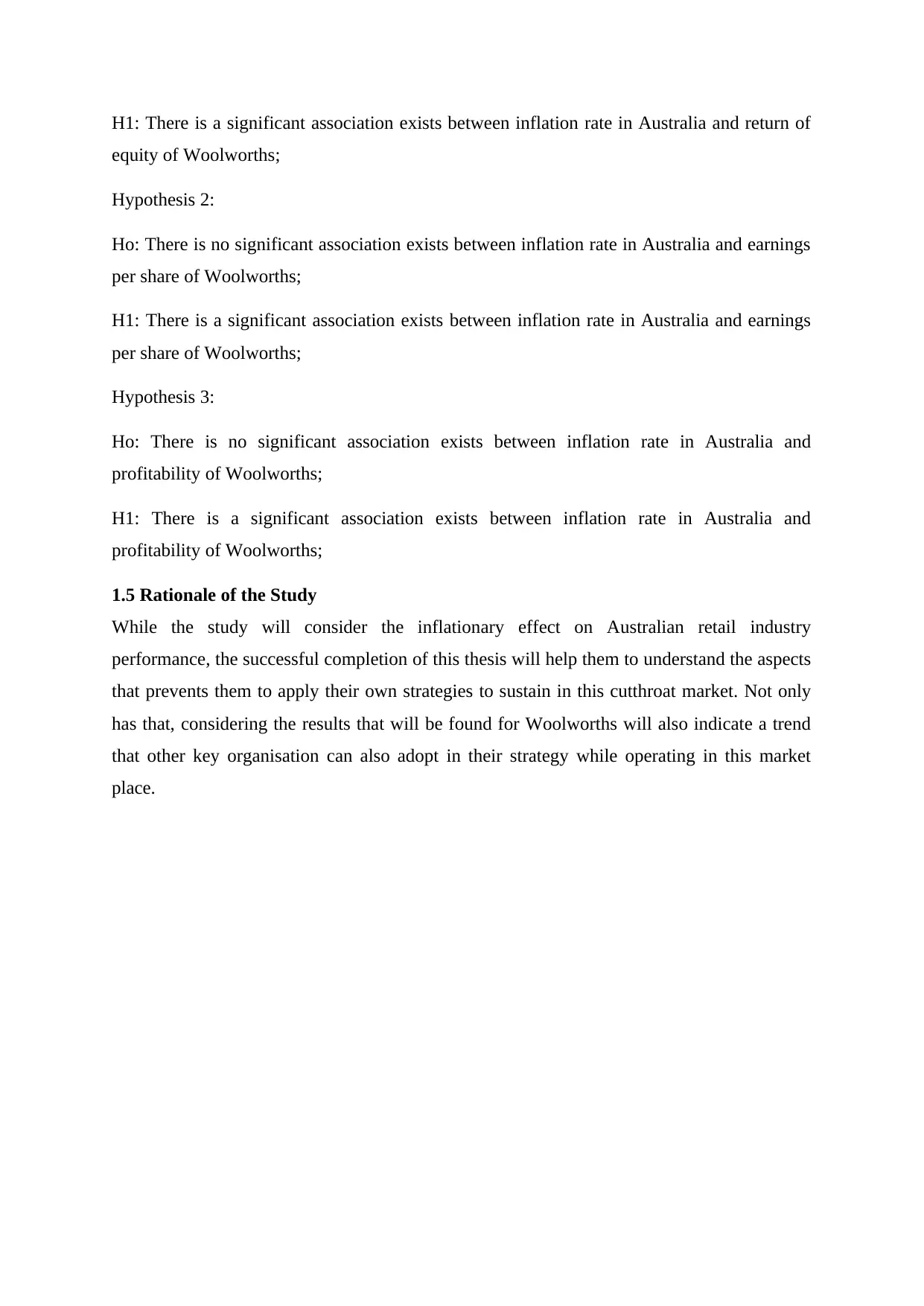
H1: There is a significant association exists between inflation rate in Australia and return of
equity of Woolworths;
Hypothesis 2:
Ho: There is no significant association exists between inflation rate in Australia and earnings
per share of Woolworths;
H1: There is a significant association exists between inflation rate in Australia and earnings
per share of Woolworths;
Hypothesis 3:
Ho: There is no significant association exists between inflation rate in Australia and
profitability of Woolworths;
H1: There is a significant association exists between inflation rate in Australia and
profitability of Woolworths;
1.5 Rationale of the Study
While the study will consider the inflationary effect on Australian retail industry
performance, the successful completion of this thesis will help them to understand the aspects
that prevents them to apply their own strategies to sustain in this cutthroat market. Not only
has that, considering the results that will be found for Woolworths will also indicate a trend
that other key organisation can also adopt in their strategy while operating in this market
place.
equity of Woolworths;
Hypothesis 2:
Ho: There is no significant association exists between inflation rate in Australia and earnings
per share of Woolworths;
H1: There is a significant association exists between inflation rate in Australia and earnings
per share of Woolworths;
Hypothesis 3:
Ho: There is no significant association exists between inflation rate in Australia and
profitability of Woolworths;
H1: There is a significant association exists between inflation rate in Australia and
profitability of Woolworths;
1.5 Rationale of the Study
While the study will consider the inflationary effect on Australian retail industry
performance, the successful completion of this thesis will help them to understand the aspects
that prevents them to apply their own strategies to sustain in this cutthroat market. Not only
has that, considering the results that will be found for Woolworths will also indicate a trend
that other key organisation can also adopt in their strategy while operating in this market
place.
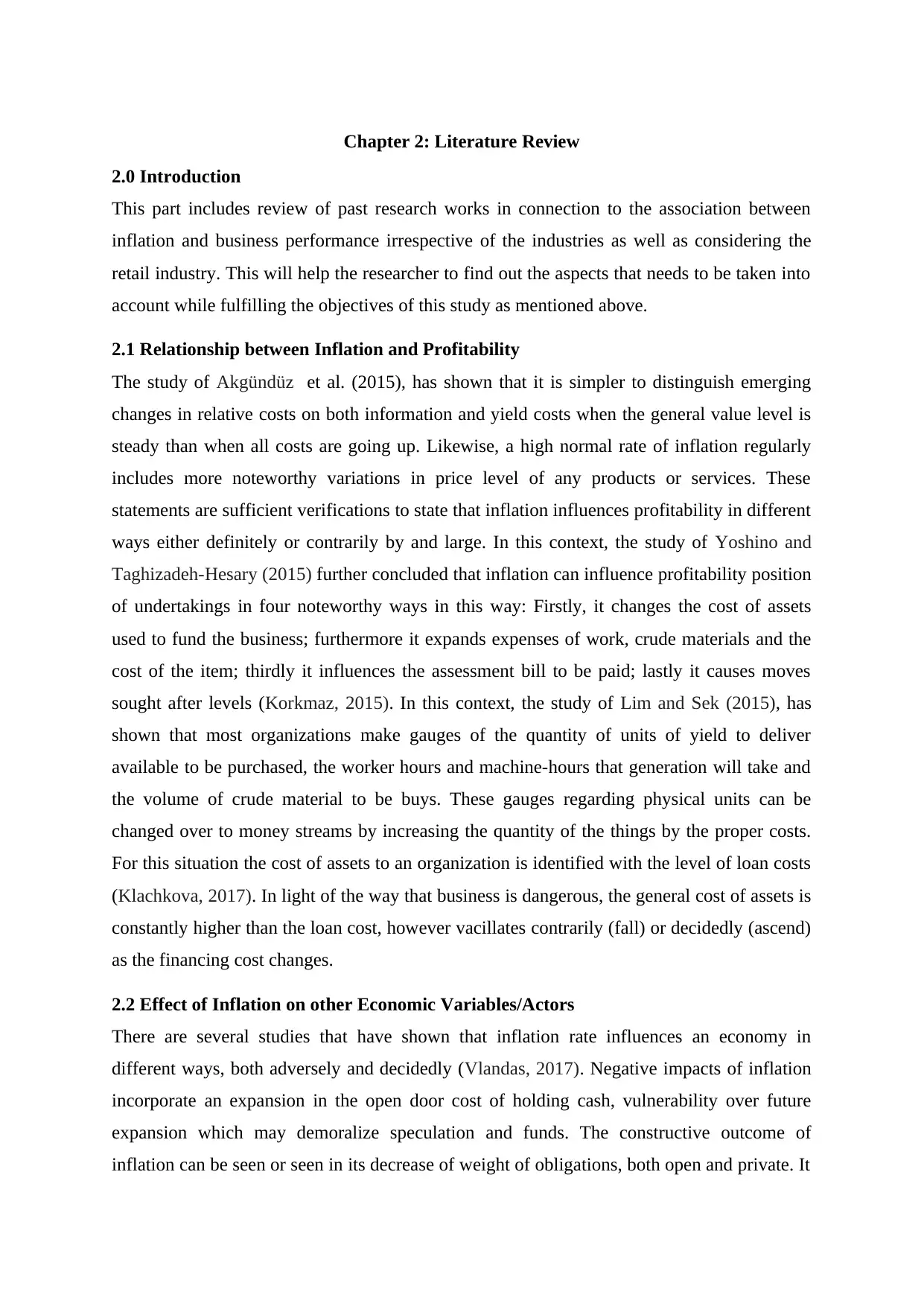
Chapter 2: Literature Review
2.0 Introduction
This part includes review of past research works in connection to the association between
inflation and business performance irrespective of the industries as well as considering the
retail industry. This will help the researcher to find out the aspects that needs to be taken into
account while fulfilling the objectives of this study as mentioned above.
2.1 Relationship between Inflation and Profitability
The study of Akgündüz et al. (2015), has shown that it is simpler to distinguish emerging
changes in relative costs on both information and yield costs when the general value level is
steady than when all costs are going up. Likewise, a high normal rate of inflation regularly
includes more noteworthy variations in price level of any products or services. These
statements are sufficient verifications to state that inflation influences profitability in different
ways either definitely or contrarily by and large. In this context, the study of Yoshino and
Taghizadeh-Hesary (2015) further concluded that inflation can influence profitability position
of undertakings in four noteworthy ways in this way: Firstly, it changes the cost of assets
used to fund the business; furthermore it expands expenses of work, crude materials and the
cost of the item; thirdly it influences the assessment bill to be paid; lastly it causes moves
sought after levels (Korkmaz, 2015). In this context, the study of Lim and Sek (2015), has
shown that most organizations make gauges of the quantity of units of yield to deliver
available to be purchased, the worker hours and machine-hours that generation will take and
the volume of crude material to be buys. These gauges regarding physical units can be
changed over to money streams by increasing the quantity of the things by the proper costs.
For this situation the cost of assets to an organization is identified with the level of loan costs
(Klachkova, 2017). In light of the way that business is dangerous, the general cost of assets is
constantly higher than the loan cost, however vacillates contrarily (fall) or decidedly (ascend)
as the financing cost changes.
2.2 Effect of Inflation on other Economic Variables/Actors
There are several studies that have shown that inflation rate influences an economy in
different ways, both adversely and decidedly (Vlandas, 2017). Negative impacts of inflation
incorporate an expansion in the open door cost of holding cash, vulnerability over future
expansion which may demoralize speculation and funds. The constructive outcome of
inflation can be seen or seen in its decrease of weight of obligations, both open and private. It
2.0 Introduction
This part includes review of past research works in connection to the association between
inflation and business performance irrespective of the industries as well as considering the
retail industry. This will help the researcher to find out the aspects that needs to be taken into
account while fulfilling the objectives of this study as mentioned above.
2.1 Relationship between Inflation and Profitability
The study of Akgündüz et al. (2015), has shown that it is simpler to distinguish emerging
changes in relative costs on both information and yield costs when the general value level is
steady than when all costs are going up. Likewise, a high normal rate of inflation regularly
includes more noteworthy variations in price level of any products or services. These
statements are sufficient verifications to state that inflation influences profitability in different
ways either definitely or contrarily by and large. In this context, the study of Yoshino and
Taghizadeh-Hesary (2015) further concluded that inflation can influence profitability position
of undertakings in four noteworthy ways in this way: Firstly, it changes the cost of assets
used to fund the business; furthermore it expands expenses of work, crude materials and the
cost of the item; thirdly it influences the assessment bill to be paid; lastly it causes moves
sought after levels (Korkmaz, 2015). In this context, the study of Lim and Sek (2015), has
shown that most organizations make gauges of the quantity of units of yield to deliver
available to be purchased, the worker hours and machine-hours that generation will take and
the volume of crude material to be buys. These gauges regarding physical units can be
changed over to money streams by increasing the quantity of the things by the proper costs.
For this situation the cost of assets to an organization is identified with the level of loan costs
(Klachkova, 2017). In light of the way that business is dangerous, the general cost of assets is
constantly higher than the loan cost, however vacillates contrarily (fall) or decidedly (ascend)
as the financing cost changes.
2.2 Effect of Inflation on other Economic Variables/Actors
There are several studies that have shown that inflation rate influences an economy in
different ways, both adversely and decidedly (Vlandas, 2017). Negative impacts of inflation
incorporate an expansion in the open door cost of holding cash, vulnerability over future
expansion which may demoralize speculation and funds. The constructive outcome of
inflation can be seen or seen in its decrease of weight of obligations, both open and private. It
⊘ This is a preview!⊘
Do you want full access?
Subscribe today to unlock all pages.

Trusted by 1+ million students worldwide
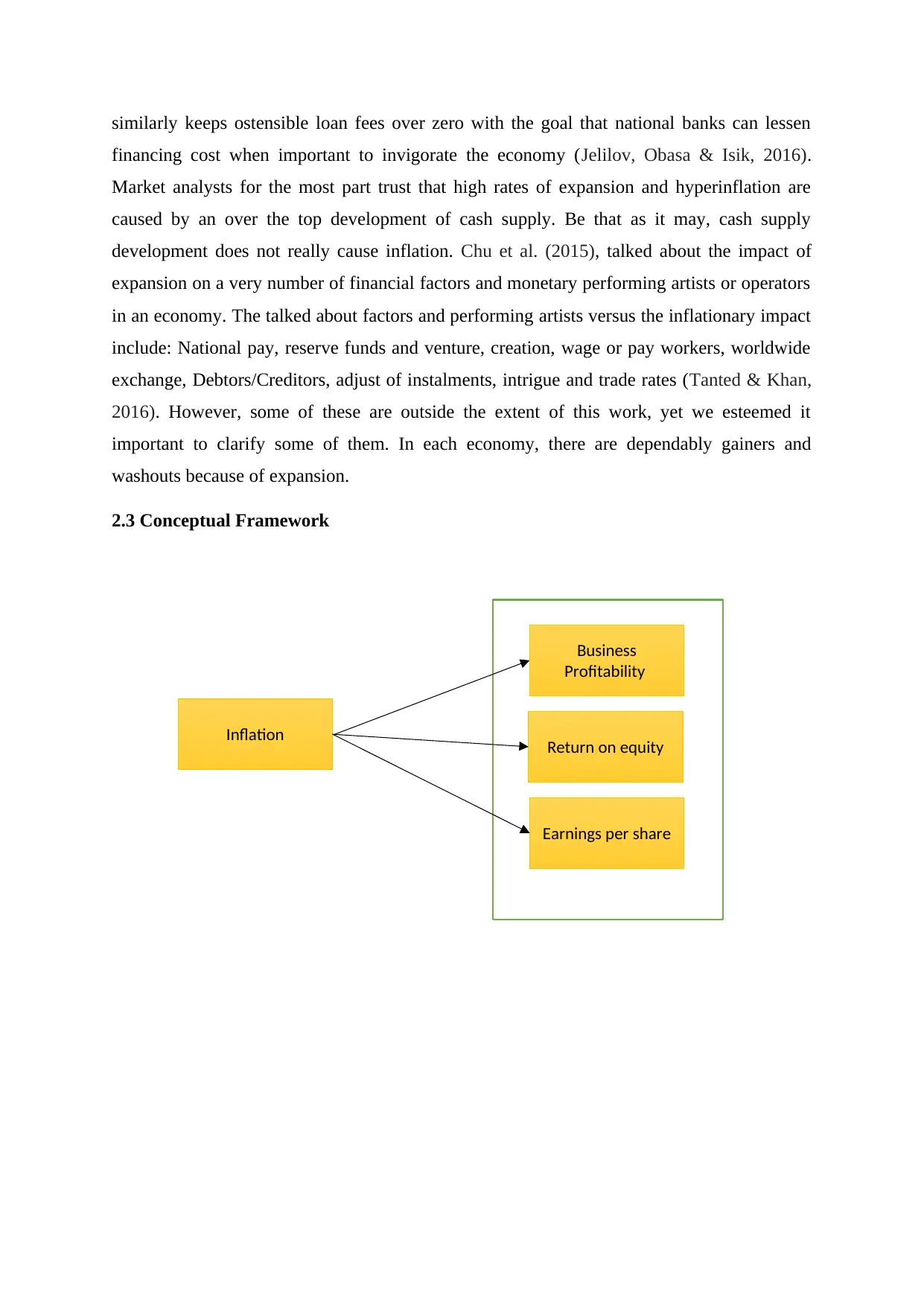
Business Performance
Inflation
Earnings per share
Return on equity
Business
Profitability
similarly keeps ostensible loan fees over zero with the goal that national banks can lessen
financing cost when important to invigorate the economy (Jelilov, Obasa & Isik, 2016).
Market analysts for the most part trust that high rates of expansion and hyperinflation are
caused by an over the top development of cash supply. Be that as it may, cash supply
development does not really cause inflation. Chu et al. (2015), talked about the impact of
expansion on a very number of financial factors and monetary performing artists or operators
in an economy. The talked about factors and performing artists versus the inflationary impact
include: National pay, reserve funds and venture, creation, wage or pay workers, worldwide
exchange, Debtors/Creditors, adjust of instalments, intrigue and trade rates (Tanted & Khan,
2016). However, some of these are outside the extent of this work, yet we esteemed it
important to clarify some of them. In each economy, there are dependably gainers and
washouts because of expansion.
2.3 Conceptual Framework
Inflation
Earnings per share
Return on equity
Business
Profitability
similarly keeps ostensible loan fees over zero with the goal that national banks can lessen
financing cost when important to invigorate the economy (Jelilov, Obasa & Isik, 2016).
Market analysts for the most part trust that high rates of expansion and hyperinflation are
caused by an over the top development of cash supply. Be that as it may, cash supply
development does not really cause inflation. Chu et al. (2015), talked about the impact of
expansion on a very number of financial factors and monetary performing artists or operators
in an economy. The talked about factors and performing artists versus the inflationary impact
include: National pay, reserve funds and venture, creation, wage or pay workers, worldwide
exchange, Debtors/Creditors, adjust of instalments, intrigue and trade rates (Tanted & Khan,
2016). However, some of these are outside the extent of this work, yet we esteemed it
important to clarify some of them. In each economy, there are dependably gainers and
washouts because of expansion.
2.3 Conceptual Framework
Paraphrase This Document
Need a fresh take? Get an instant paraphrase of this document with our AI Paraphraser
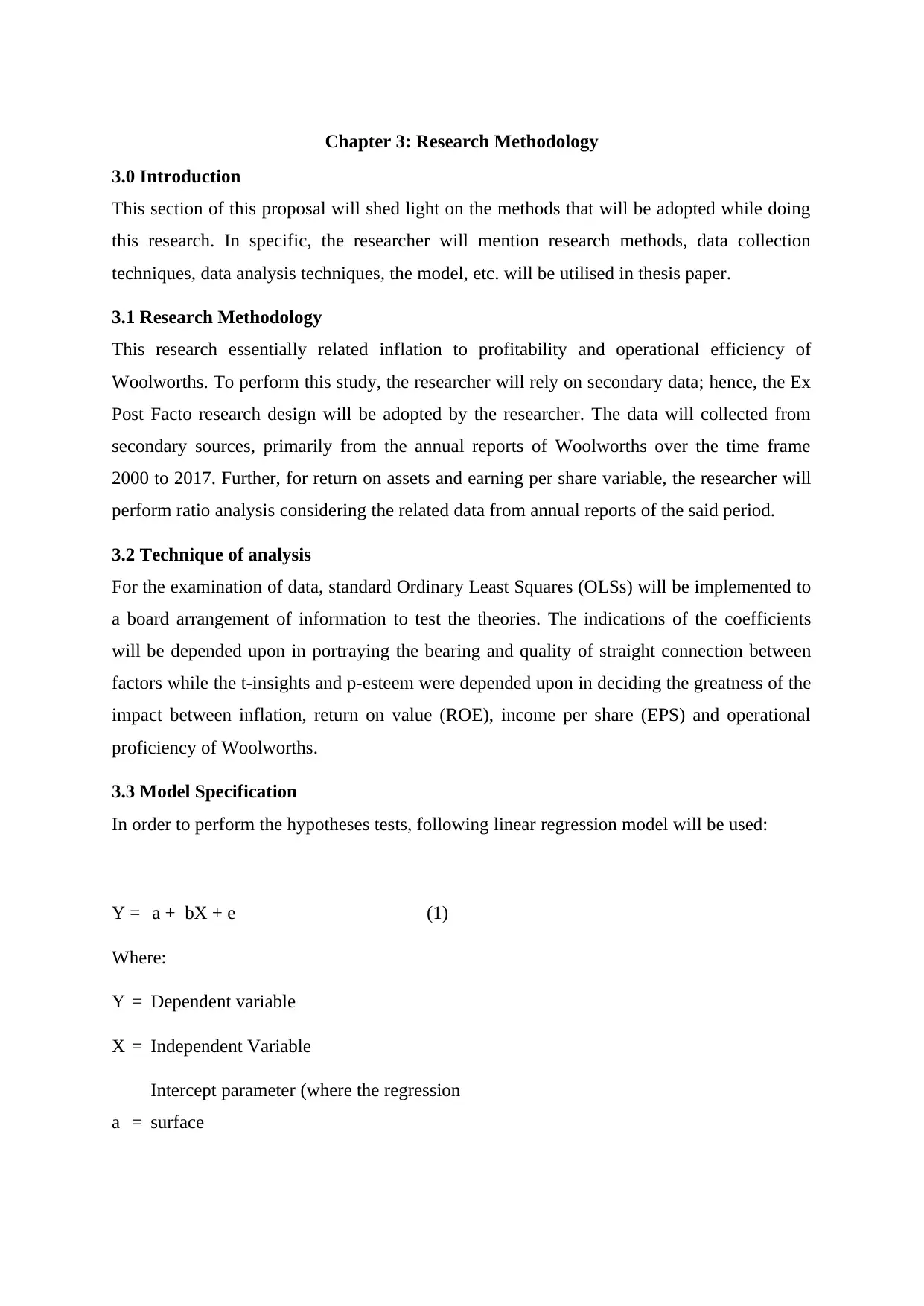
Chapter 3: Research Methodology
3.0 Introduction
This section of this proposal will shed light on the methods that will be adopted while doing
this research. In specific, the researcher will mention research methods, data collection
techniques, data analysis techniques, the model, etc. will be utilised in thesis paper.
3.1 Research Methodology
This research essentially related inflation to profitability and operational efficiency of
Woolworths. To perform this study, the researcher will rely on secondary data; hence, the Ex
Post Facto research design will be adopted by the researcher. The data will collected from
secondary sources, primarily from the annual reports of Woolworths over the time frame
2000 to 2017. Further, for return on assets and earning per share variable, the researcher will
perform ratio analysis considering the related data from annual reports of the said period.
3.2 Technique of analysis
For the examination of data, standard Ordinary Least Squares (OLSs) will be implemented to
a board arrangement of information to test the theories. The indications of the coefficients
will be depended upon in portraying the bearing and quality of straight connection between
factors while the t-insights and p-esteem were depended upon in deciding the greatness of the
impact between inflation, return on value (ROE), income per share (EPS) and operational
proficiency of Woolworths.
3.3 Model Specification
In order to perform the hypotheses tests, following linear regression model will be used:
Y = a + bX + e (1)
Where:
Y = Dependent variable
X = Independent Variable
a =
Intercept parameter (where the regression
surface
3.0 Introduction
This section of this proposal will shed light on the methods that will be adopted while doing
this research. In specific, the researcher will mention research methods, data collection
techniques, data analysis techniques, the model, etc. will be utilised in thesis paper.
3.1 Research Methodology
This research essentially related inflation to profitability and operational efficiency of
Woolworths. To perform this study, the researcher will rely on secondary data; hence, the Ex
Post Facto research design will be adopted by the researcher. The data will collected from
secondary sources, primarily from the annual reports of Woolworths over the time frame
2000 to 2017. Further, for return on assets and earning per share variable, the researcher will
perform ratio analysis considering the related data from annual reports of the said period.
3.2 Technique of analysis
For the examination of data, standard Ordinary Least Squares (OLSs) will be implemented to
a board arrangement of information to test the theories. The indications of the coefficients
will be depended upon in portraying the bearing and quality of straight connection between
factors while the t-insights and p-esteem were depended upon in deciding the greatness of the
impact between inflation, return on value (ROE), income per share (EPS) and operational
proficiency of Woolworths.
3.3 Model Specification
In order to perform the hypotheses tests, following linear regression model will be used:
Y = a + bX + e (1)
Where:
Y = Dependent variable
X = Independent Variable
a =
Intercept parameter (where the regression
surface
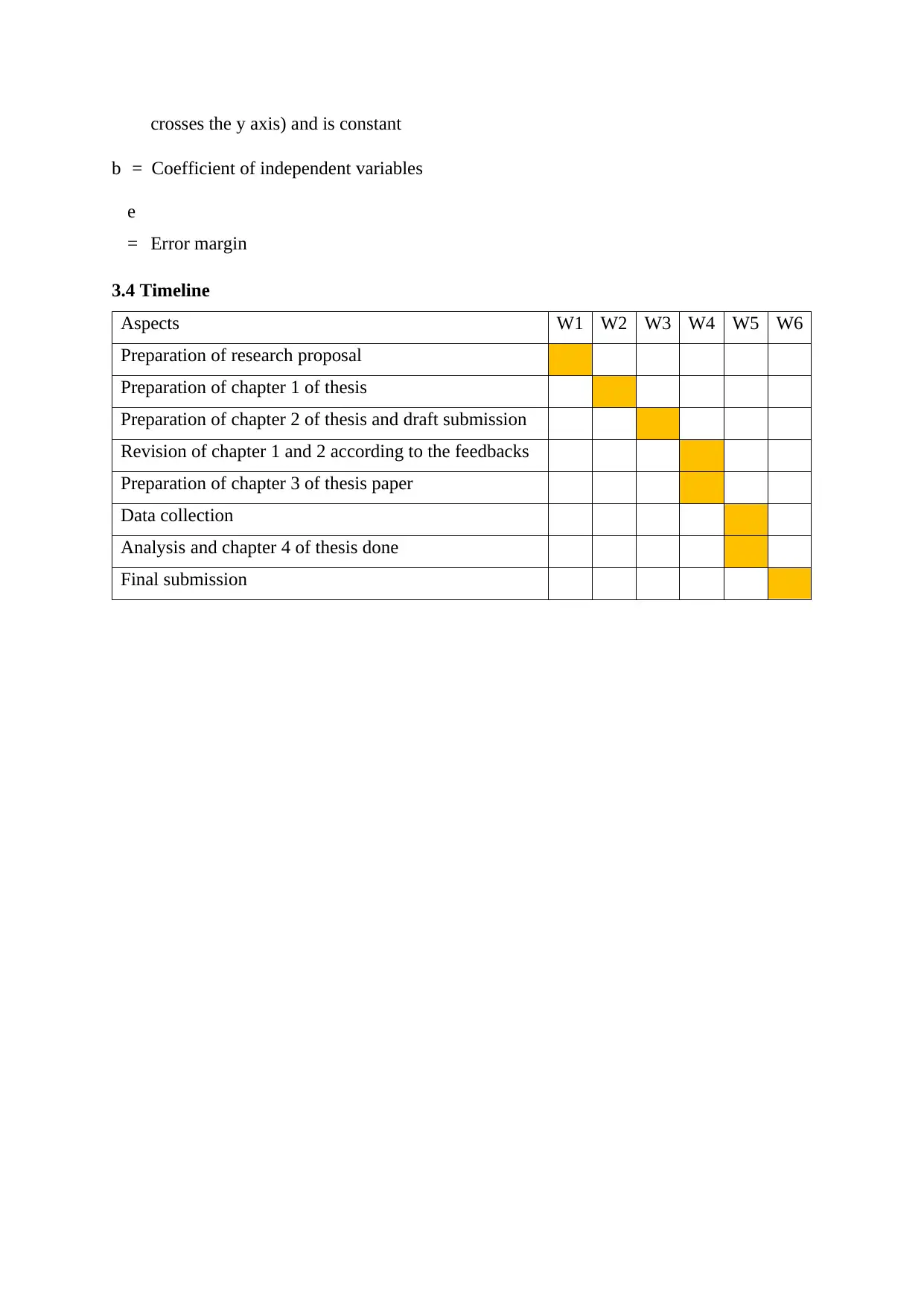
crosses the y axis) and is constant
b = Coefficient of independent variables
e
= Error margin
3.4 Timeline
Aspects W1 W2 W3 W4 W5 W6
Preparation of research proposal
Preparation of chapter 1 of thesis
Preparation of chapter 2 of thesis and draft submission
Revision of chapter 1 and 2 according to the feedbacks
Preparation of chapter 3 of thesis paper
Data collection
Analysis and chapter 4 of thesis done
Final submission
b = Coefficient of independent variables
e
= Error margin
3.4 Timeline
Aspects W1 W2 W3 W4 W5 W6
Preparation of research proposal
Preparation of chapter 1 of thesis
Preparation of chapter 2 of thesis and draft submission
Revision of chapter 1 and 2 according to the feedbacks
Preparation of chapter 3 of thesis paper
Data collection
Analysis and chapter 4 of thesis done
Final submission
⊘ This is a preview!⊘
Do you want full access?
Subscribe today to unlock all pages.

Trusted by 1+ million students worldwide

References
Akgündüz, Y., Van den Berg, M., & Hassink, W. (2015). The impact of refugee crises on
host labor markets: the case of the Syrian refugee crisis in Turkey.
Ashraf, Q., Gershman, B., & Howitt, P. (2016). How inflation affects macroeconomic
performance: an agent-based computational investigation. Macroeconomic dynamics, 20(2),
558-581.
Baddon, L., Ramsay, H., Hunter, L., Hyman, J., & Leopold, J. (2017). People's capitalism?:
a critical analysis of profit-sharing and employee share ownership. Routledge.
Bertay, A. C., Demirgüç-Kunt, A., & Huizinga, H. (2015). Bank ownership and credit over
the business cycle: Is lending by state banks less procyclical?. Journal of Banking &
Finance, 50, 326-339.
Bhamra, H. S., Dorion, C., Jeanneret, A., & Weber, M. (2017). Low Inflation: High Default
Risk AND High Equity Valuations.
Chu, A. C., Cozzi, G., Lai, C. C., & Liao, C. H. (2015). Inflation, R&D and growth in an
open economy. Journal of International Economics, 96(2), 360-374.
Galí, J. (2015). Monetary policy, inflation, and the business cycle: an introduction to the new
Keynesian framework and its applications. Princeton University Press.
Jelilov, G., Obasa, O. J., & Isik, A. (2016). Impact of Inflation and Unemployment on
Economic Growth in Ten (10) Selected Member’s States of Economic Community of West
Africa States (ECOWAS)(2001-2014). Advances in Economics and Business, 4(5), 222-244.
Klachkova, O. A. (2017). Modelling the Impact of Inflation on Economic Growth for
Countries with Different Levels of Economic Freedom. Economic Policy, 5, 22-41.
Korkmaz, S. (2015). Impact of bank credits on economic growth and inflation. Journal of
Applied Finance and Banking, 5(1), 51.
Lim, Y. C., & Sek, S. K. (2015). An examination on the determinants of inflation. Journal of
Economics, Business and Management, 3(7), 678-682.
Tanted, N., & Khan, G. (2016). An Empirical Study on the Impact of Exchange Rate and
Inflation Rate on NSE Index. AAYAM: AKGIM Journal of Management, 6(2), 27.
Akgündüz, Y., Van den Berg, M., & Hassink, W. (2015). The impact of refugee crises on
host labor markets: the case of the Syrian refugee crisis in Turkey.
Ashraf, Q., Gershman, B., & Howitt, P. (2016). How inflation affects macroeconomic
performance: an agent-based computational investigation. Macroeconomic dynamics, 20(2),
558-581.
Baddon, L., Ramsay, H., Hunter, L., Hyman, J., & Leopold, J. (2017). People's capitalism?:
a critical analysis of profit-sharing and employee share ownership. Routledge.
Bertay, A. C., Demirgüç-Kunt, A., & Huizinga, H. (2015). Bank ownership and credit over
the business cycle: Is lending by state banks less procyclical?. Journal of Banking &
Finance, 50, 326-339.
Bhamra, H. S., Dorion, C., Jeanneret, A., & Weber, M. (2017). Low Inflation: High Default
Risk AND High Equity Valuations.
Chu, A. C., Cozzi, G., Lai, C. C., & Liao, C. H. (2015). Inflation, R&D and growth in an
open economy. Journal of International Economics, 96(2), 360-374.
Galí, J. (2015). Monetary policy, inflation, and the business cycle: an introduction to the new
Keynesian framework and its applications. Princeton University Press.
Jelilov, G., Obasa, O. J., & Isik, A. (2016). Impact of Inflation and Unemployment on
Economic Growth in Ten (10) Selected Member’s States of Economic Community of West
Africa States (ECOWAS)(2001-2014). Advances in Economics and Business, 4(5), 222-244.
Klachkova, O. A. (2017). Modelling the Impact of Inflation on Economic Growth for
Countries with Different Levels of Economic Freedom. Economic Policy, 5, 22-41.
Korkmaz, S. (2015). Impact of bank credits on economic growth and inflation. Journal of
Applied Finance and Banking, 5(1), 51.
Lim, Y. C., & Sek, S. K. (2015). An examination on the determinants of inflation. Journal of
Economics, Business and Management, 3(7), 678-682.
Tanted, N., & Khan, G. (2016). An Empirical Study on the Impact of Exchange Rate and
Inflation Rate on NSE Index. AAYAM: AKGIM Journal of Management, 6(2), 27.
Paraphrase This Document
Need a fresh take? Get an instant paraphrase of this document with our AI Paraphraser

Vlandas, T. (2017). Grey power and the Economy: Aging and Inflation Across Advanced
Economies. Comparative Political Studies, 0010414017710261.
Yoshino, N., & Taghizadeh-Hesary, F. (2015). Effectiveness of the easing of monetary policy
in the Japanese economy, incorporating energy prices. Journal of Comparative Asian
Development, 14(2), 227-248.
Economies. Comparative Political Studies, 0010414017710261.
Yoshino, N., & Taghizadeh-Hesary, F. (2015). Effectiveness of the easing of monetary policy
in the Japanese economy, incorporating energy prices. Journal of Comparative Asian
Development, 14(2), 227-248.
1 out of 11
Related Documents
Your All-in-One AI-Powered Toolkit for Academic Success.
+13062052269
info@desklib.com
Available 24*7 on WhatsApp / Email
![[object Object]](/_next/static/media/star-bottom.7253800d.svg)
Unlock your academic potential
Copyright © 2020–2025 A2Z Services. All Rights Reserved. Developed and managed by ZUCOL.





